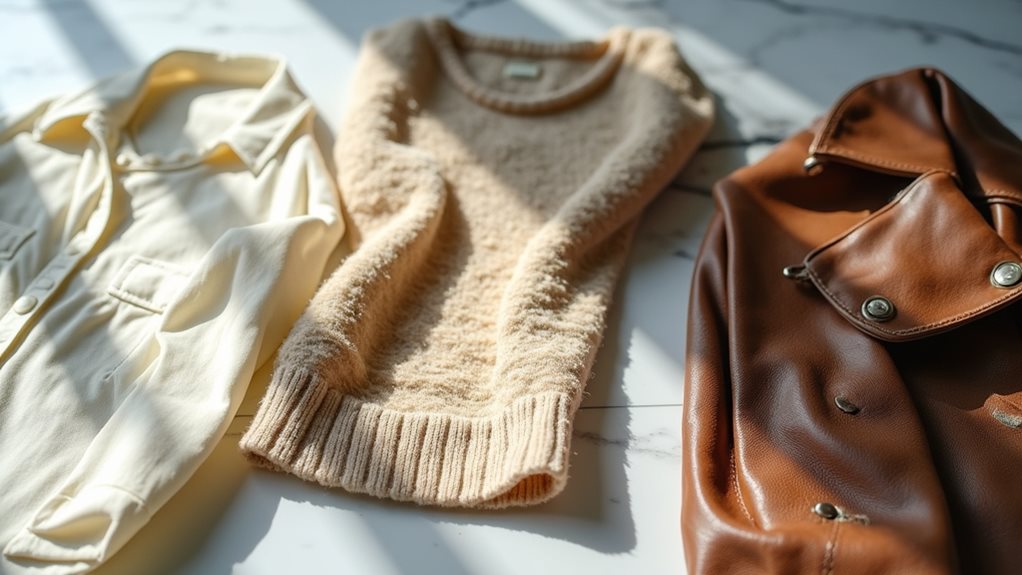You’ll typically wait 1-2 days for standard items like dress shirts, though I’ve learned the hard way that delicate garments and formal wear can take 3-5 days depending on fabric complexity. Wedding dresses? Plan for weeks 😅 At-home dry cleaning kits work faster at about an hour, but they’re not suitable for everything. Peak times, heavily soiled items, and equipment limitations can extend your wait, so plan ahead for special occasions to discover the best strategies for each garment type.
The Dry Cleaning Process and How It Affects Turnaround Time
When I first started using dry cleaning services, I’ll admit I was completely clueless about why my favorite blazer took three days to come back while my husband’s dress shirts were ready the next afternoon – turns out, the complexity of the five-step dry cleaning process directly impacts how long you’ll be separated from your garments.
Each piece goes through drop-off, inspection, cleaning, pressing, and quality control, and this turnaround time varies dramatically based on what you’re bringing in.
Every garment follows the same five-step journey, but your blazer’s fabric complexity determines whether you’ll wait two days or five.
Standard clothing items like dress shirts typically breeze through in 1-2 days, while delicate garments need extra TLC and can take 3-4 days.
Larger items like comforters require even more time, and tricky stains and fabric type can add days to your wait! 😅
Many dry cleaners offer same-day service for an additional fee if you need your garments returned quickly for special events or urgent occasions.
How Long Does Dry Cleaning Take for Different Garments?

Why does your silk blouse take twice as long as your cotton dress shirt, you might wonder – and honestly, I used to think all clothes were treated the same until I learned that different garments have vastly different timelines based on their fabric, construction, and care requirements.
Here’s what you can expect for dry cleaning time and turnaround:
- Standard clothing like dress shirts and trousers typically need 1-2 days for the cleaning process.
- Delicate fabrics and garments with intricate details require 3-4 days or more.
- Large items such as comforters can take up to a week.
Wedding dress cleaning demands special attention, sometimes requiring weeks for proper preservation.
Formal suits usually need 3-5 days for thorough cleaning turnaround, while your everyday garments move through much faster.
Many dry cleaners offer same-day service for an additional fee when you need items cleaned urgently.
Time Estimates When Dry Cleaning at Home

When you’re considering tackling dry cleaning at home, you’ll want to understand the specific steps involved and how much time you’re really committing to the process.
I remember my first attempt at DIY dry cleaning, thinking I’d save both money and time, only to discover that while it’s definitely faster than dropping clothes off professionally, there’s still a methodical process that requires your attention and patience.
The entire home dry cleaning process, from pre-treating those stubborn stains to letting your garments rest after the tumble cycle, typically spans about 30 minutes to an hour, though the actual hands-on time you’ll spend is surprisingly minimal.
Home dry cleaning kits work best for light stains and general refreshing rather than intensive cleaning that requires the powerful solvents found in professional services.
DIY Process Steps
While professional dry cleaning might leave you waiting days for results, tackling the process at home puts you completely in control of the timeline.
Honestly, it’s become one of my favorite weekend shortcuts since I discovered just how manageable it really is. The DIY dry cleaning steps flow together seamlessly, making your overall time investment surprisingly minimal.
Here’s how the home dry cleaning process breaks down:
- Pre-treatment and loading: Spend about 5 minutes treating visible stains and placing garments in your cleaning bag with the cleaning sheet.
- Tumble drying process: Let the cleaning solution work its magic for 30-60 minutes while you tackle other tasks.
- Final rest period: Allow 10-15 minutes for cleaning agents to dissipate completely.
The entire process keeps you busy for maybe 10 minutes total, while your dryer does the heavy lifting. Before starting any home dry cleaning process, always test the method on an inconspicuous area first to ensure it won’t damage the fabric.
Total Time Required
Once you factor in every single step from grabbing that wrinkled blazer to hanging it back in your closet, the complete DIY dry cleaning timeline clocks in at a revitalizing predictable 30 minutes to one hour.
Honestly, discovering this efficiency completely changed my approach to garment care. Your total time required breaks down beautifully: pre-treatment for visible stains takes mere minutes, loading garments into the cleaning bag happens in a flash, then tumble drying does the heavy lifting for 30-60 minutes while the cleaning solution works its magic.
The post-treatment phase requires just a brief wait before you’re done. This method works particularly well for delicate fabrics like wool and silk that would typically require professional care. Compare this quick turnaround to traditional dry cleaning services, and you’ll wonder why you ever waited days for clean clothes!
Other Reasons You Might Wait Longer for Your Dry Cleaning

Beyond the typical processing timeframes, several factors can unexpectedly stretch your dry cleaning pickup date further into the future than you’d planned.
Understanding these potential delays helps you plan better and avoid the frustration of showing up expecting clean clothes that aren’t ready yet.
Planning ahead for potential dry cleaning delays prevents the disappointment of arriving to find your garments still being processed.
- Peak times and local events create customer volumes that overwhelm even well-staffed cleaners, leading to longer wait times for garment processing.
- Staff limitations during busy periods mean fewer hands handling your items, naturally extending cleaning times when you need service most.
- Extremely soiled clothes require additional cleaning time and specialized treatment, which can delay your entire order if mixed with regular items.
- Equipment capacity limitations at your dry cleaner can create bottlenecks that slow down the entire cleaning process, especially when specialty treatments are required for certain fabrics or stains.
Timing your drop-offs strategically around these factors saves everyone headaches!
Items You Can’t Dry Clean

Although dry cleaning seems like a magical solution for most garments, certain items will leave you disappointed, frustrated, and potentially out some serious money if you attempt to clean them this way.
Fur garments shouldn’t go near dry cleaning because those chemical solvents strip away natural oils, turning your luxurious coat into a brittle mess.
Leather and suede need unique care that standard cleaning can’t provide, while heavily beaded or embellished pieces risk losing their sparkly details.
I’ve seen too many people cry over damaged antique textiles and delicate fabrics that couldn’t handle the harsh chemicals.
These materials have damaged fibers that’ll only worsen with traditional dry cleaning, so save yourself the heartache! 💔
Additionally, everyday items like cotton t-shirts, jeans, and athletic wear are designed for regular washing and would be unnecessarily expensive to dry clean while potentially losing their intended performance properties.
Proper Ways to Store Dry-Cleaned Items

After investing your hard-earned money in professional dry cleaning, you’ll want to protect that investment by storing your garments properly.
Proper storage is the key to maximizing your dry cleaning investment and keeping garments looking pristine longer.
I’ve learned the hard way that even the most expensive cleaning job can be ruined by careless storage. When dry cleaners return your delicate fabrics, don’t just hang them anywhere and forget about them.
Here’s how to store dry-cleaned items correctly:
- Choose breathable garment bags over plastic covers to prevent moisture buildup that leads to mold disasters 😬
- Use acid-free tissue paper inside structured pieces to prevent creasing and maintain their shape beautifully.
- Regularly check stored garments for signs of damage, pests, or humidity issues before problems become permanent.
This is especially important for delicate fabrics like silk, wool, and cashmere, which can be easily damaged by improper storage conditions that affect their texture and appearance.
Trust me, these simple steps will preserve garments for years, saving you countless trips back to professional cleaners.




